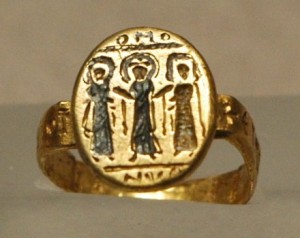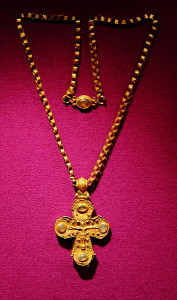One of the big trends in jewellery at the moment is pieces which take their inspiration from another age or culture, whether that be massive tribal necklaces or jewellery which features ancient Celtic symbols and knots. One of the cultures which is providing most inspiration to jewellery makers currently is the Byzantine Empire, but what exactly is the Byzantine Empire and what does the jewellery look like?
Greeks and Romans
At the peak of its power, the Roman empire covered all of the Mediterranean and as far north as Scotland. As the years passed and the Roman power declined, the eastern part of the Mediterranean developed into a new civilisation which became known as the Byzantine Empire. Although the boundaries of this new empire followed the rough boundaries of the Roman Empire, the language and culture were Greek. The capital of the Byzantine Empire was in Constantinople, which is now known as Istanbul. The Byzantines remained strong until the 14th century, when the Empire was broken up and the Ottoman Empire ruled.
Jewellery
The Byzantines used what they had to hand to create stunning pieces of jewellery. Most of the jewellery which survives today in collections such as the British Museum is made from gold, but they also made use of precious stones like diamonds and pearls. Chains were an integral part of the design of most Byzantine jewellery and they produced highly intricate work with lots of tiny bits of gold linked around each other and around the precious stones which made up the rest of the piece. Many Byzantines were Christians, so there are also a lot of crosses and religious imagery on pendants and bracelets which survive from this period.
Modern Take
Although more than a thousand years old, the style and good design of Byzantine jewellery means that the pieces can still be easily worn today. Makers such as Hultquist Jewellery use Byzantine inspiration in their range of bracelets and beaded earrings and many other top notch designers produce similar items. Modern techniques mean that we can make similar looking jewellery without using the precious gold and emeralds and simulated pearls are readily available and cheap.
Getting the Byzantine Look
It’s not just in jewellery that the Byzantine style is fashionable, so if you have invested in a pair of strappy “gladiator” style sandals for the summer, the ideal accessory is a pair of earrings from Hultquist jewellery or a handmade heavy chain to wear around your neck or your wrist. Keep the embellishment simple, and choose pearls or gold as the main look of the jewellery. Shiny metallic fabrics which have been seen recently on the catwalk evoke the Byzantine look, but the key to getting this look right is moderation; nobody wants to look as if they are wearing a sheet of tin foil. The same goes for the jewellery, so invest in a couple of good quality key pieces rather than draping yourself head to toe in heavy chains and Byzantine inspired bracelets.
Byline
Article by Morag Peers a keen blogger with a passion for fine jewellery.


